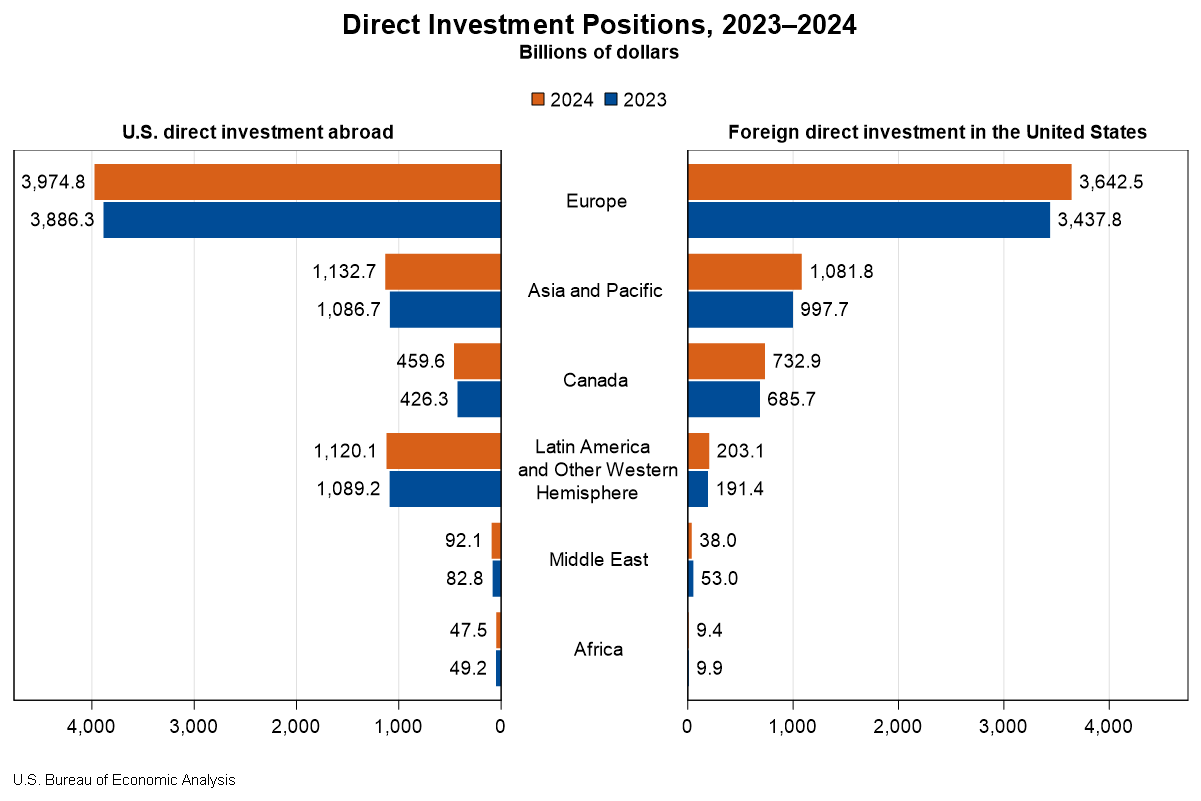Bureau of Economic Analysis
Direct Investment by Country and Industry, 2024
The U.S. direct investment abroad position, or cumulative level of investment, increased $206.3 billion to $6.83 trillion at the end of 2024, according to statistics released today by the U.S. Bureau of Economic Analysis. The increase was led by an $88.4 billion increase in the position in Europe, primarily in Luxembourg and Germany. By industry, manufacturing affiliates had the largest increase, led by manufacturing of computers and electronic products.
The foreign direct investment in the United States position increased $332.1 billion to $5.71 trillion at the end of 2024. The increase was led by a $204.7 billion increase in the position from Europe, which reflected a $52.9 billion increase from the United Kingdom and a $39.7 billion increase from Germany. By industry, affiliates in manufacturing increased the most.
Principal Federal Economic Indicators
Noteworthy
- 2025 News Release Schedule
- Innovation at BEA
- 2025 Annual Updates
- New! Services Trade Data for More Countries
- Data Tool: Trade in Value Added
- Distribution of State Personal Income
- Updated: RIMS II Regional Multipliers
- Arts and Culture
- Space Economy
- FDI Now in State BEARFACTS
- Quick Guide: Price Indexes
The Latest
Gross Domestic Product for American Samoa, 2013
This release is available as a PDF download.
BEA to Release 2013 Metro-Area GDP Statistics Sept. 16
Statistics on the 2013 economic performance of the nation’s 381 metropolitan areas will be released Tuesday, Sept. 16 at 8:30 a.m. EDT by the U.S. Bureau of Economic Analysis (BEA).
The release will also include revised statistics for the years 2001-2012, along with maps of the eight BEA economic regions and a table detailing the contributions of thirteen principal industries to the economic growth of each area. The news release,…
American Samoa Economy Shrinks in 2013; Consumer Spending Grows
Estimates of gross domestic product (GDP) for American Samoa show that real GDP — adjusted to remove price changes — decreased 2.4 percent in 2013. In contrast, real GDP for the U.S. (excluding the territories) increased 2.2 percent in 2013.
The decline in the American Samoa economy reflected a decrease in territorial government spending that was partly offset by increases in consumer spending and private fixed investment.
Brian Moyer Named New BEA Director
Brian Moyer was named Director of the Bureau of Economic Analysis, bringing more than 20 years of experience in economic statistics to the post. His new status as Director takes effect Sept. 21.
Dr. Moyer is currently BEA’s Deputy Director and has served as Acting Director since May 2 when the agency’s previous chief retired.
July 2014 Trade Gap is $40.5 Billion
The U.S. monthly international trade deficit decreased in July 2014 according to the U.S. Bureau of Economic Analysis and the U.S. Census Bureau. The deficit decreased from $40.8 billion in June (revised) to $40.5 billion in July as exports increased more than imports. The previously published June deficit was $41.5 billion. The goods deficit decreased $0.2 billion from June to $60.2 billion in July; the services surplus was nearly unchanged…
Real Consumer Spending Falls in July
Personal Income rose 0.2 percent in July after rising 0.5 percent in June. Wages and salaries, the largest component of personal income, rose 0.2 percent in July after rising 0.4 percent in June.
Current-dollar disposable personal income (DPI), after-tax income rose 0.1 percent in July after rising 0.5 percent in June.
Real DPI, income adjusted for taxes and inflation, increased 0.1 percent in July after…
Personal Income and Outlays, July 2014
Personal income increased $28.6 billion, or 0.2 percent, and disposable personal income (DPI) increased $17.7 billion, or 0.1 percent, in July, according to the Bureau of Economic Analysis. Personal consumption expenditures (PCE) decreased $13.6 billion, or 0.1 percent. In June, personal income increased $67.1 billion, or 0.5 percent, DPI increased $62.9 billion, or 0.5 percent, and PCE increased $50.5 billion, or 0.4 percent, based on…
GDP Up in Second Quarter
Real gross domestic product (GDP) increased 4.2 percent in the second quarter of 2014, according to the “second” estimate released by the Bureau of Economic Analysis. In the first quarter, real GDP decreased 2.1 percent. The second-quarter growth rate was revised up 0.2 percentage point from the “advance” estimate released in July.
Second-quarter highlights
The upturn in real GDP growth was primarily driven by the following:…
Gross Domestic Product, 2nd quarter 2014 (second estimate); Corporate Profits, 2nd quarter 2014 (preliminary estimate)
Real gross domestic product -- the output of goods and services produced by labor and property located in the United States -- increased at an annual rate of 4.2 percent in the second quarter of 2014, according to the "second" estimate released by the Bureau of Economic Analysis. In the first quarter, real GDP decreased 2.1 percent. The GDP estimate released today is based on more complete source data than were available for the…




